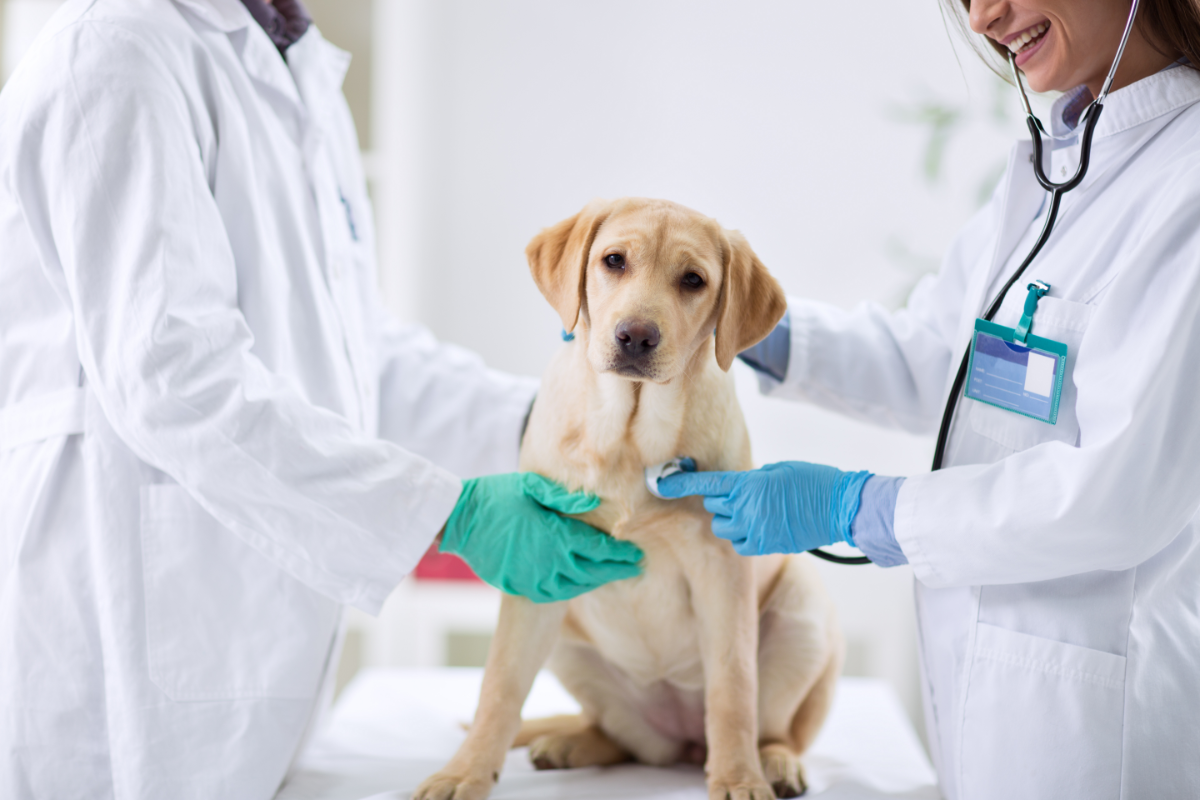Canine distemper is often unknown to dog owners. It is a serious threat to canine health. This viral infection is most common in puppies and young dogs. However, it can affect dogs of any age. The CDV virus (Canine Distemper Virus) targets the respiratory, gastrointestinal and nervous systems. Symptoms vary from mild to fatal. Vaccination can effectively prevent this disease. This underlines the importance of awareness and prevention in protecting our four-legged friends. In France, the law of 22 June 1989 classifies canine distemper as a redhibitory defect.
What is distemper?
Canine distemper is a contagious viral disease that affects various animals but cannot be transmitted to humans. Caused by a paramyxovirus similar to the agents of measles and rinderpest, it mainly affects canids (dogs, wolves, foxes), certain mustelids (mink, ferrets), raccoons – the leading cause of death in certain regions – and possibly marmots and wild felids. It can also affect other carnivores, including marine carnivores.
Symptoms include fever, runny nose and eyes, as well as respiratory, gastrointestinal and sometimes neurological problems. Hyperkeratosis of the nose and pads may occur in rare cases. Once widespread, distemper has become rarer in regions where preventive vaccination is widely adopted. However, it is still common in certain areas and in wild species. Although it is not transmissible to humans, it requires extra vigilance because its symptoms can be similar to those of rabies, a fatal disease that can be transmitted to humans.
Pathophysiology
Infection by the distemper virus is transmitted essentially by direct contact and exposure of mucous membranes to infectious droplets. After penetration, the virus is carried by macrophages to key organs such as the spleen, thymus and bone marrow, where it multiplies. Without adequate immunity, it infects the epithelium of the respiratory, digestive and nervous systems, causing severe symptoms and a high risk of mortality, especially in the presence of opportunistic infections.
This paramyxovirus, closely related to the measles and rinderpest viruses, has a single antigen but varies in pathogenicity. It is sensitive to disinfectants, but is resistant to freezing. Neurological damage mainly affects the cerebellum and can take two forms: neuronal necrosis with lymphoplasmacytic accumulations, or demyelination leading to axonal degeneration.
Canine distemper can range from mild discomfort to a fatal outcome, particularly in puppies. Incubation lasts from 3 to 10 days, followed by a biphasic fever and the appearance of specific symptoms and superinfections. It mainly affects unvaccinated young dogs aged between 3 and 6 months, but can occasionally affect vaccinated adults. A precise diagnosis often requires additional tests. Other wild species may also be affected, underlining the importance of effective prevention through vaccination.
Transmission of the disease
Distemper is highly contagious, transmitted mainly by aerosols or contact with infected body fluids (saliva, urine, faeces, nasal and eye discharge). An animal can remain contagious 90 days after infection, even without visible symptoms.
Contagiousness in dogs begins one week after exposure and can persist for up to four months. The virus is sensitive to UV rays, heat and dryness, but survives in the cold, remaining active at 4°C for weeks.
The incubation period varies from one to six weeks, followed by similar symptoms. Transmission occurs mainly via coughing, sneezing and direct contact, spreading the virus in enclosed spaces such as kennels, especially in winter. However, the virus rapidly dissipates outdoors and is eliminated by common disinfectants.
The disease is not transmitted to humans, eliminating the risk of contagion between dogs and owners. Although indirect contact is a less effective route of transmission because of the fragility of the virus in the heat, the spread of the disease in winter accentuates the risk of contagion, underlining the difficulty of eradicating this virus because of its ease of transmission.
Evolution of the disease
Following inhalation of the virus, it spreads to macrophages, then to local lymphoid tissues such as the bronchial tonsils and lymph nodes, where replication begins 2 to 4 days after infection. Primary viremia occurs between 4 and 6 days, spreading the virus to lymphoid and haematopoietic tissues, causing lymphonia and immunosuppression. Around days 8 to 9, secondary viremia can spread the virus to various epithelial tissues and the CNS, mainly affecting the epithelium of the bronchial and gastrointestinal tracts and glands. Other cells such as keratinocytes, fibroblasts and endothelial cells may also be infected. CNS involvement is a major complication.
Between days 9 and 14, the course of the infection depends on the virulence of the strain of CDV, the age of the animal and its immune status. Dogs’ immune responses can be divided into two categories:
- Rapid cure: thanks to an effective and early humoral and cellular immune response, neutralising the virus without clinical signs.
- Weak immune response: leading to an acute, sub-acute or chronic form of the disease, with bacterial superinfection and obvious symptoms.
In puppies under three months of age without passive maternal immunity, the disease is often fatal. Symptoms vary with age, including haemorrhagic diarrhoea, dehydration and inappetence. Haemorrhagic enteritis is common.
Initial clinical expression may include mild hyperthermia and general symptoms. Distinct phases of the disease include catarrhal inflammation and a period of dominant localisation, with a diversity of symptoms depending on the organs affected, potentially leading to severe and classic forms of the disease. The prognosis varies, leading to death, recovery or recovery with sequelae.
What are the symptoms?
The symptoms of distemper vary widely depending on the species and the animal’s immune response, including:
- Passivity and aimless wandering;
- Nervous disorders such as partial paralysis, poor co-ordination, excessive salivation, convulsions and convulsive chewing;
- Behavioural changes, such as loss of fear of humans or atypical aggression in wild animals;
- Conjunctivitis, runny nose, and respiratory problems;
- Skin problems such as pustules and hyperkeratosis;
- Digestive disorders including vomiting and bloody diarrhoea, often linked to rapid dehydration;
- Dental and testicular lesions.
Between 25% and 75% of infected dogs may show no signs at all, while others show one or more of the symptoms listed. Early signs often include discharge from the eyes and nose. Half of all dogs, especially those with nervous symptoms, may die, partly because the virus weakens the immune system.
The incubation period varies from 3 to 10 days, followed by a biphasic fever and the appearance of characteristic symptoms and superinfections. Neurological symptoms may occur if the disease is prolonged, with possible sequelae in survivors.
The diagnosis of distemper in a young dog is based on an incomplete vaccination history and the presence of characteristic symptoms. Additional tests, such as PCR, are often required to confirm the diagnosis due to the variability of symptoms. The disease is transmitted mainly via the respiratory tract and direct contact with infected secretions. In the advanced stages, the virus reaches the central nervous system, causing a variety of symptoms depending on the organ affected.
The animal’s immune response is crucial to recovery. If the immune response is weak or delayed, the disease can spread and be fatal, particularly in puppies.
Epidemiology
The global and European distribution of distemper in wildlife has recently been identified, with cases reported in Spain, Italy (2006), Germany (2008), Switzerland (2009), Belgium and France (2019). Genetic typing of strains by the ONCFS/Réseau SAGR reveals a similarity between European strains, particularly those from Italy and Switzerland.
A vaccine is available for domestic dogs and ferrets, but its use in wildlife remains limited, with the exception of conservation programmes such as the one to protect the black-footed ferret in North America.
The 1994 epidemic in the Serengeti decimated a third of the lion population, underlining the seriousness of the disease. Transmission occurs mainly through direct contact and exposure of mucous membranes to viral particles. Once in the body, the virus attacks the respiratory, digestive and nervous organs in the absence of immunity, with a high risk of mortality.
Studies on raccoons in Ontario have revealed wild viral strains that are distinct from vaccine strains, emphasising the importance of the eco-epidemiology of this disease. The infection is not considered a zoonosis, and no link has been established with human diseases such as multiple sclerosis.
CDV is ubiquitous and specific to canids, affecting a wide range of carnivores. Dogs, as the main reservoirs, play a crucial role in the transmission of the disease, which also occurs in many other carnivores, including mustelids and ursids. Canine distemper is most risky in unvaccinated dogs between three and six months of age, although it can also affect older animals with weakened immunity. Vaccination remains crucial in preventing the spread of this virus, particularly in animal communities.
How can this fatal disease be treated?
There is no specific effective treatment for distemper; management focuses on supportive care. Vaccination remains the most effective form of protection. Unvaccinated animals may succumb to infection or suffer permanent sequelae. Treatment includes antibiotics to combat superinfections and infusions to counter dehydration caused by vomiting and diarrhoea.
If distemper is diagnosed, drug treatment will aim to relieve the animal’s suffering and reduce the risk of further infection.Hospitalisation may be necessary to treat dehydration. Survivors may suffer physical and neurological sequelae.
The prognosis is particularly poor for dogs showing nervous signs, which account for around 50% of cases. Affected dogs require isolation and hospitalisation, often on a drip, to administer broad-spectrum antibiotics, anti-inflammatories, antivirals, anti-vomiting agents, anti-diarrhoeals and painkillers.
Medical costs can be considerable, which is why it is so important to take out pet health insurance. Even with appropriate treatment, recovery is not guaranteed and irreversible after-effects are possible. Prevention through vaccination is essential to avoid this disease. In the event of symptoms, immediate veterinary consultation is crucial, as the disease can be fatal in 50% of cases.
How can you help your pet naturally after such an ordeal?
After intensive treatment and hospitalisation, your dog will benefit from targeted nutritional care to accelerate healing and strengthen its immune system. Probiotics, food supplements rich in live micro-organisms, help to rebalance the intestinal flora altered by antibiotic treatment. Although certain fermented foods offer a natural source of probiotics, their concentration remains low compared with specific food supplements, which are resistant to gastric acid and rich in various bacterial strains.
Vitamins play a key role in a dog’s recovery, with each type having specific functions:
- Vitamin A: essential for vision, reproduction and skin health.
- B vitamins: support energy metabolism and the nervous system.
- Vitamin C: improves iron absorption, immune defences and fights ageing.
- Vitamin D: crucial for the absorption of calcium and phosphorus, strengthening bones.
- Vitamin E: an antioxidant that protects cells and supports muscular health.
- Vitamin K: important for blood clotting and bone health.
Minerals and essential fatty acids such as manganese, omega-3 and zinc also contribute to the dog’s general health, particularly for the skin, coat, heart and kidney functions. The addition of probiotics helps to restore the balance of the intestinal flora, essential for good digestion.
Plant extracts such as echinacea purpurea, astragalus and rosehip can stimulate the immune system. You can also give your dog bramble bud glycerol macerate to help oxygenate tissues and speed up recovery. To manage post-hospital stress, Bach flowers are recommended for their soothing effect without interfering with other treatments or supplements.
Vaccination, the best form of prevention
Canine distemper, a highly contagious virus, remains a major threat to unvaccinated dogs, despite the existence of an effective vaccine that generates an appropriate immune response. Vaccination, which is essential from the puppy’s first weeks of life, has significantly reduced the number of cases. Nevertheless, there are still pockets of infection, especially in large conurbations with large unvaccinated dog populations.
Puppies initially benefit from maternal antibodies, which protect them temporarily. Vaccination should be carried out as soon as this protection wears off, typically at 9 weeks, with an annual or triennial booster to maintain immunity.
With no specific treatment to eliminate the virus, management focuses on medical support and prevention of superinfections, involving infusions, broad-spectrum antibiotics, anti-inflammatories and other symptomatic drugs. Despite this, dogs can suffer irreversible after-effects.
The prognosis is particularly precarious for animals showing neurological symptoms. For puppies at risk, it is advisable to limit contact with other dogs and avoid high-risk areas until the vaccination protocol has been completed.
The relatively modest cost of the vaccine is fully justified in view of the risks and potential expenses associated with the disease. Vaccination is the most reliable defence against distemper, the absence of which exposes the animal to a potentially fatal outcome.
In the event of contact with potentially infected wild or domestic animals, rigorous prevention and hygiene measures are essential. The virus can be neutralised by common disinfectants, such as a dilute bleach solution, minimising the risk of transmission.





